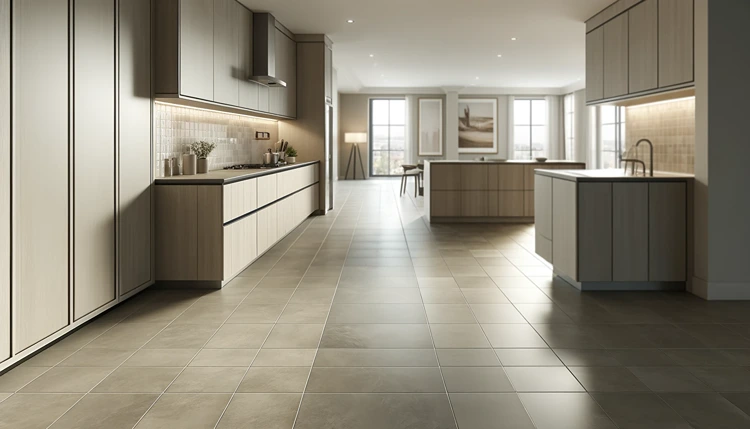What to Look for When Selecting Ceramic Tile for Any Space

Ceramic tile can completely transform any space, offering style, durability, and versatility. But with so many options available, it can be tough to figure out what’s right for your home. Whether you’re redoing your kitchen backsplash, upgrading the bathroom, or even looking for a chic flooring solution, selecting ceramic tile involves more than just picking what looks good. It’s about balancing aesthetics, practicality, and long-term durability.
What’s the Best Tile Size for Your Space?
One of the first things to consider when selecting ceramic tile for any space is the size of the tile. Tile size can dramatically impact the look and feel of a room, and choosing the right size depends on the dimensions of the area you’re working with.
Smaller Spaces, Smaller Tiles?
It might seem logical to use smaller tiles in small spaces, but that’s not always the best choice. While small tiles can add intricate detail to a room, they often come with more grout lines, which can make a small space feel even more cramped. Larger tiles, on the other hand, create a more seamless, spacious feel by reducing the number of grout lines.
Helpful Hint:
If you want to make a small bathroom or kitchen feel larger, consider using larger ceramic tiles—at least 12×12 inches or bigger. This trick visually enlarges the space, making it feel less cluttered.
Large Spaces, Large Tiles
In large, open rooms like living areas or spacious kitchens, larger tiles (18×18 inches or even 24×24 inches) can look more proportional. They offer a modern, clean aesthetic and make it easier to maintain the space because there are fewer grout lines to clean. However, don’t go too large if the room has many fixtures or elements, as this might throw off the visual balance.
How Does Tile Durability Affect Your Choice?
Not all ceramic tiles are created equal, and some are better suited for high-traffic areas than others. When selecting ceramic tile for any space, understanding the tile’s durability is crucial for ensuring longevity and avoiding unnecessary wear and tear.
PEI Rating: What Does It Mean?
Tiles come with a PEI rating, which stands for the Porcelain Enamel Institute’s rating of tile hardness. This rating helps you understand where the tile is best used. For instance:
- PEI 1: Suitable for walls only.
- PEI 2: Ideal for low-traffic areas like bathrooms.
- PEI 3: Perfect for residential areas with average foot traffic, like kitchens and entryways.
- PEI 4: Can handle heavy foot traffic and is good for both residential and light commercial use.
- PEI 5: The most durable tiles, often used in commercial spaces with heavy foot traffic.
Stats:
Studies show that high-traffic areas, such as kitchens and hallways, benefit significantly from using ceramic tiles with a PEI rating of 3 or higher. This not only ensures durability but also reduces the need for frequent replacements.
Why Water Absorption Matters
Another key consideration when selecting ceramic tile is water absorption. The last thing you want is a tile that absorbs moisture, leading to cracks, mold, or damage over time. In areas prone to moisture, such as bathrooms or kitchens, look for tiles with low water absorption rates.
Ceramic tiles are typically categorized as follows based on their water absorption:
- Non-vitreous: Absorbs more than 7% water, not suitable for wet areas.
- Semi-vitreous: Absorbs 3-7% water, good for some dry spaces but not ideal for moisture-prone areas.
- Vitreous: Absorbs 0.5-3% water, suitable for most residential spaces, including kitchens.
- Impervious: Absorbs less than 0.5% water, perfect for bathrooms, showers, and outdoor use.
What’s the Right Tile Finish for Your Space?
The finish of ceramic tile not only influences how it looks but also how it feels and functions. Your choice between glossy, matte, or textured finishes depends on both the style you want and the function of the room.
Glossy Tiles: Are They Practical?
Glossy tiles are often chosen for their sleek, shiny appearance, which adds a sense of luxury to any room. However, while they may look stunning, they aren’t always practical for every space. Glossy finishes tend to show water spots, smudges, and dirt more easily, which can be a hassle in high-traffic or moisture-heavy areas like bathrooms or kitchens.
Matte Tiles: A Good All-Rounder?
For spaces where practicality is key, matte ceramic tiles are often the better choice. They don’t show dirt and smudges as easily as glossy tiles and offer a more understated, modern look. Their slightly textured surface also makes them less slippery, which is an important safety feature in wet areas.
Helpful Hint:
If you’re tiling a bathroom or kitchen, consider using matte tiles for the floors to reduce the risk of slipping. Save glossy finishes for walls where style matters more than function.
How Does Tile Color and Pattern Influence Your Space?
When selecting ceramic tile for any space, the color and pattern you choose will have a huge impact on the room’s atmosphere. The right tile can set the mood, create a focal point, or even influence how large or small the space feels.
How to Choose the Right Tile Color?
The color of your ceramic tile should complement the overall color scheme of the room while also considering factors like natural light and room size. Here’s a breakdown of how to think about tile color in different spaces:
- Light Colors: Light-colored tiles, such as whites, creams, or soft pastels, are great for making small rooms feel bigger and brighter. They reflect light, helping create a more open, airy feeling.
- Dark Colors: Dark tiles, like charcoal, navy, or black, can add sophistication and warmth to a large space. However, they can make small rooms feel more confined, especially if the room lacks natural light.
- Neutral Tones: Neutral tones like beige, gray, and taupe are versatile choices that blend well with a variety of design styles. They work in any room, giving you flexibility to change up the decor without having to replace the tiles.
Helpful Hint:
If you want a timeless look that won’t go out of style, stick to neutral or soft colors for your ceramic tiles. These tones are not only easy to pair with furniture and decor, but they also make it easier to sell your home in the future, as they appeal to a wider audience.
Should You Go for Bold Patterns or Simple Designs?
Patterned tiles are all the rage these days, and for good reason. They add personality and flair to a room, turning an otherwise simple space into a design feature. But there’s a balance between bold and overpowering.
- Bold Patterns: These are great for creating a focal point in the room. For instance, a patterned tile backsplash in the kitchen can be a stunning design element. However, avoid using bold patterns on every surface, as it can make the space feel busy and overwhelming.
- Simple Designs: Simple, minimalist tile designs are perfect for creating a sleek, modern look. They work well in larger spaces where you want to emphasize openness and tranquility without too many distractions.
Combining Colors and Patterns: Is It a Good Idea?
Yes, combining different tile colors or patterns can work wonders when done thoughtfully. For instance, you can use a bold patterned tile as an accent in a shower or backsplash while keeping the surrounding tiles neutral and simple. This creates a striking visual without overwhelming the entire space.
How Important Is Tile Installation and Maintenance?
No matter how beautiful or durable your ceramic tile is, poor installation or inadequate maintenance can ruin the look and longevity of your investment. That’s why it’s crucial to pay attention to these details when selecting ceramic tile for any space.
What’s the Best Grout for Your Tile?
Grout might seem like a minor detail, but it plays a big role in the overall appearance and functionality of your tiled surface. Grout color can either blend in with your tile for a seamless look or stand out to highlight the tile pattern.
- Matching Grout: If you want a clean, minimalist look, choose a grout color that matches your tile. This approach works especially well with large-format tiles or when you want the tile to be the star of the show.
- Contrasting Grout: For a more bold, graphic look, choose a grout color that contrasts with your tile. Black grout with white tiles, for example, creates a striking, modern appearance.
How to Maintain Your Ceramic Tile
Ceramic tiles are known for being low-maintenance, but that doesn’t mean they’re completely maintenance-free. To keep them looking their best, it’s important to clean and care for them properly.
Here are a few essential tips for maintaining your ceramic tile:
- Regular Cleaning: Use a mild cleaner and a soft mop or cloth to clean your tiles regularly. Avoid abrasive materials that could scratch the surface.
- Grout Sealing: Grout can absorb moisture and dirt, leading to stains over time. Sealing the grout every few years will help keep it looking fresh and prevent stains.
- Avoid Harsh Chemicals: Harsh cleaners, especially those containing acid or bleach, can damage both your tile and grout. Stick to gentle, pH-neutral cleaners for the best results.
Helpful Hint:
For high-traffic areas like kitchens or hallways, consider using mats or rugs to protect your tile from dirt and heavy wear. This will help extend the lifespan of both the tile and grout, reducing the need for repairs or replacement.
What Tile Should You Use for Wet Areas?
When it comes to wet areas like bathrooms, showers, or outdoor patios, you need to be extra careful in selecting ceramic tile. Not every tile is suitable for these spaces, and using the wrong kind can lead to slippery floors or water damage.
Slip Resistance: Why It Matters
The texture of your tile plays a major role in how safe it is for wet areas. Tiles that are too smooth can become dangerously slippery when wet, which is why it’s important to choose tiles with slip resistance in mind.
- Textured Tiles: Opt for tiles with a textured or matte finish in wet areas. These surfaces provide better traction, reducing the risk of slips and falls.
- Anti-Slip Ratings: Many tiles come with a slip resistance rating, often called a Coefficient of Friction (COF) rating. For bathrooms, showers, or outdoor areas, look for tiles with a high COF to ensure they’re safe to walk on when wet.
Water Resistance: What Type of Tile Works Best?
As mentioned earlier, tiles with a low water absorption rate are essential for wet areas. You’ll want to choose ceramic tiles that are either vitreous or impervious to prevent issues like mold, mildew, or damage from long-term exposure to moisture.
In bathrooms or showers, glazed ceramic tiles are a great option. They have an extra protective layer that makes them more water-resistant, which is perfect for spaces that see a lot of moisture.
What Are the Latest Design Trends in Ceramic Tiles?
Ceramic tiles have evolved far beyond simple squares or rectangles. Today’s trends bring in a wide range of shapes, textures, and patterns, offering endless options to suit your personal style and the design of any space.
Geometric Shapes: Are They Here to Stay?
Geometric tiles have been a huge hit in recent years, and their popularity doesn’t seem to be fading. Shapes like hexagons, triangles, and even diamond-shaped tiles can add visual interest and a modern touch to your home.
- Hexagon Tiles: These are perfect for creating a contemporary feel, whether you use them on the floor or as a feature wall. They can be arranged in a variety of patterns to suit your space and design style.
- Penny Tiles: Small round tiles, often referred to as penny tiles, are another trendy choice. These are ideal for creating vintage or retro looks and are commonly used for bathroom floors or kitchen backsplashes.
- Fish Scale Tiles: For a more artistic flair, fish scale or scallop-shaped tiles offer a unique, wavy texture that works beautifully in bathrooms and kitchens.
Wood-Look Tiles: Why Are They So Popular?
Wood-look ceramic tiles continue to be a popular choice for homeowners who love the warmth of wood but need the durability and water resistance of tile. These tiles mimic the look of real wood, complete with grain textures and natural wood tones.
Wood-look tiles are ideal for high-traffic areas like kitchens, hallways, or bathrooms, where traditional wood flooring might not hold up well against moisture or heavy wear. They’re available in a variety of shades, from light, bleached oak to rich, dark walnut, allowing you to achieve the natural wood look without sacrificing durability.
Handmade and Artisan Tiles: Worth the Investment?
Handmade or artisan tiles are gaining popularity for their unique, one-of-a-kind appeal. These tiles often have slight variations in color and texture, adding character and charm to any room. They work particularly well in smaller applications, such as backsplashes, accent walls, or fireplaces, where you want to create a striking focal point.
While artisan tiles can be more expensive than mass-produced options, their durability and aesthetic value make them worth the investment, especially if you want to add a truly custom element to your home.
How to Find High-Quality Ceramic Tile at a Budget-Friendly Price
Ceramic tiles can range in price from very affordable to high-end luxury, but there are ways to get great quality without breaking the bank. Here are some tips for finding high-quality ceramic tile for any space, even on a tight budget.
Shop Around and Compare Prices
One of the easiest ways to save money on ceramic tile is to shop around. Visit multiple tile stores, both in-person and online, to compare prices and styles. Keep an eye out for sales or discounts, especially when buying in bulk. Many stores offer discounts when you purchase a certain amount of square footage.
Consider Outlet or Clearance Tiles
Tile outlets or clearance sections can be gold mines for finding high-quality tiles at discounted prices. These are often tiles that are being phased out or have been overstocked. While the selection might be limited, you can often find beautiful tiles for a fraction of the original price.
Buy Extra for Future Repairs
When you find a tile you love, be sure to buy extra. Purchasing an additional 10-15% of tile is recommended in case of breakage during installation or future repairs. This is especially important if you’re buying clearance or discontinued tiles, as they may not be available later on if you need to replace a few.
Stats:
A recent survey showed that buying an additional 10% of tile during the initial purchase saves homeowners an average of 20% on repair costs in the long term, as they can avoid hunting for matching tiles later on.
How Can You Ensure a Successful Tile Installation?
Proper installation is just as important as selecting the right tile. Even the highest-quality tile can look poor if it’s not installed correctly. Whether you’re tackling a DIY project or hiring a professional, there are a few key points to keep in mind to ensure the best results.
Hiring a Professional vs. DIY: Which Is Better?
If you’re skilled with home improvement projects, installing ceramic tile yourself can be a satisfying and cost-effective option. However, if you’re not experienced, hiring a professional is usually worth the investment to avoid costly mistakes.
For large spaces or complicated designs, professional installation is recommended to ensure that tiles are laid evenly and grout lines are straight. Improper installation can lead to crooked tiles, uneven surfaces, and gaps in grout that can allow moisture to seep in, causing long-term damage.
Prepping the Surface: Why Is It Important?
Before you begin tiling, it’s essential to properly prepare the surface. Make sure the surface is clean, dry, and level to prevent tiles from shifting or cracking over time. Any imperfections in the surface can lead to problems down the line, so take your time with this step.
For floors, it’s also crucial to make sure the subfloor is strong enough to support the weight of the tiles. If the subfloor isn’t stable, it could cause the tiles to crack or loosen over time.
Don’t Rush the Grout
Grouting may seem like the final, simple step in tile installation, but it’s critical to do it correctly. Be sure to follow the manufacturer’s instructions and allow the grout enough time to cure. Wipe away excess grout carefully to avoid staining the tiles, and ensure that grout lines are filled evenly.
Wrapping Up
Selecting ceramic tile for any space is a decision that balances style, functionality, and durability. By considering factors like tile size, water resistance, durability ratings, and aesthetics, you can choose the perfect ceramic tile that not only enhances your home’s design but also stands the test of time. Whether you’re upgrading a small bathroom or laying down tiles in a large kitchen, remember that the right tile can completely transform the look and feel of any space.


